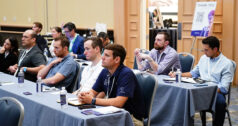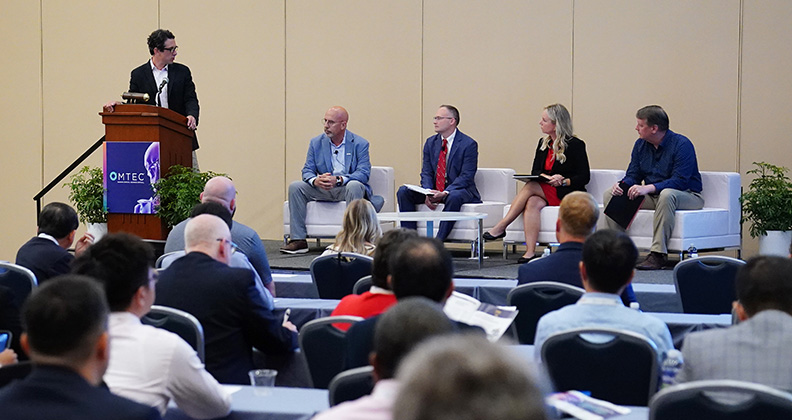
OMTEC 2024 was a tremendous success, and the annual event continues to cement its reputation as the can’t-miss conference for top orthopedic industry professionals. If you weren’t among the 1,600 decision-makers at this year’s conference, here’s a look at a few of the hot-topic education sessions you missed.
OSMA Addresses Regulatory Challenges
The opening day of OMTEC’s education sessions was presented in collaboration with the Orthopaedic Surgical Manufacturers Association (OSMA), a device company-led organization that works to enhance the implementation of global regulations and foster productive interactions between the orthopedic industry and regulators.
OSMA-supported education focused on navigating EU MDR regulations, mastering the shifting biocompatibility landscape, understanding the global audit landscape and proven ways to overcome today’s top regulatory challenges.
Ehab Esmail, Senior VP of Global Quality, Regulatory, and Clinical Affairs at Orthofix and President of OSMA, addressed MDR’s nuances, interpretations and challenges associated with the requirement for clinical evidence.
“This presents a significant hurdle for many in the orthopedic industry, as it demands clinical data for predicate and subject devices,” he said. “That’s a departure from past practices where class II devices often did not require such data.”
Clinical study design controls are standardized globally, and the regulatory focus is shifting significantly to clinical data requirements, Esmail pointed out. “Orthopedic companies must carefully strategize whether to prioritize U.S. or European markets based on their ability to gather clinical data, either retrospectively or prospectively,” he added. “This decision profoundly impacts product innovation and market entry strategies.”
Esmail noted that differentiating between significant and substantial changes to a product’s design after MDR certification is critical under the updated regulatory landscape. “Consulting with regulatory affairs specialists is essential to understand the impact on timelines and costs before implementing changes,” he said.
The burdens of MDR regulations are forcing many companies to reconsider their presence in European markets, according to Esmail. “However,” he said, “it’s important to recognize that these challenges — stringent design controls and validation requirements — are increasingly global and not unique to Europe.”
Tackling Difficult Conversations
During an interactive session on the conference’s second day, the challenging topic of the best ways to approach difficult conversations was tackled by Mary Abbajay, President of Careerstone Group.
Abbajay said difficult conversations involve topics that business leaders often hesitate to discuss, such as providing negative feedback and addressing performance issues or conflict in the workplace. Leaders often avoid the topics because they fear negative reactions and don’t want to hurt employees’ feelings.
“If you fear that people are going to be angry or defensive or upset, then I want to put your fears aside,” Abbajay told attendees. “The truth is that people are going to be defensive. They are going to be a little upset.”
That doesn’t mean difficult conversations should be avoided. “I need to have difficult conversations all the time,” Abbajay said. “I don’t love them and I don’t look forward to them, but I’m good at them because I’ve learned how to do it.”
Abbajay emphasized that a difficult conversation must have a positive intention behind it. “If it’s about providing feedback, it needs to be constructive and helpful to the other person,” she said. “If it’s about accountability, it should aim to strengthen the relationship or the agreement you had. The key to a successful difficult conversation is ensuring that you and the other person understand the positive intention behind it.”
Abbajay also noted that difficult conversations need to be timely. “Address issues as soon as possible after they occur, whether it’s for feedback or accountability,” she said. “If you wait too long, the issues can fester and become more problematic.”
Recent research indicates that the more time spent dwelling on how a problem, conflict or situation occurred, the more likely both sides are to entrench themselves in their perspectives.
“To avoid this, quickly identify and name the situation, conflict behavior or failing, then shift the focus to the future,” Abbajay advised. “Ask questions like, ‘What are we going to do about this?’ or ‘How are we going to resolve this dispute?’ This forward-looking approach is one of the most effective strategies you can use.”
Assessing the Sterilization Landscape
As the U.S. Environmental Protection Agency (EPA) enacts initiatives to limit ethylene oxide (EO) sterilization, the demand for alternative sterilization methods is increasing and creating strong market competition. Wendy Mach, Senior Director of Technical Services at Canyon Labs, addressed this dynamic during a breakout session on the conference’s last day.
The EPA recently implemented the first phase of changes expected to impact the orthopedic industry. As Mach noted, one key aspect that wasn’t included in their initial draft, which had caused significant concern, was the proposed limits on exposure cycles.
“Currently, most cycles range between 400 and 600 milligrams per liter,” she said. “However, the finalized document did not include the requirement to reduce exposures to less than 500 milligrams per liter. This omission has brought considerable relief to stakeholders in the industry.”
She discussed navigating sterilization validation requirements and associated regulatory aspects. She also touched on the three main sterilization techniques in use today — gamma radiation, steam and EO — and their roles moving forward.
Mach pointed out that EO still dominates the market with 50% of the sterilization capabilities, followed by gamma radiation at 40%. She added that E-beam, which is becoming more prevalent, currently holds 5% of the market share. The remaining 5% comprises novel sterilization technologies.
“In the future, we expect the applications of E-beam to increase as the use of gamma decreases,” Mach said. “There are many helpful guidance documents available to facilitate the transition from gamma to E-beam, making it an easier shift.”
Mach stressed the importance of sterilization as a step within the overall manufacturing process, not a standalone event. “You need to consider sterilization from the very beginning of the product development cycle, starting with the design phase,” she added.
Sterilization plays a critical role in ensuring the safety and functionality of medical devices. “The key is adaptation and flexibility in response to evolving needs,” Mach said. “EO continues to dominate due to its scalability and remains essential for managing large product volumes. However, concerns such as penetration and material compatibility persist and must be addressed.”
Alternative sterilization methods are garnering increased interest across the industry, broadening options for items previously limited by traditional approaches.
“There are a lot of different modalities that are entering the market, and it’s going to be exciting to see how they develop,” Mach said. “This will allow for greater flexibility and innovation in sterilization practices.”
DC
Dan Cook is a Senior Editor at ORTHOWORLD. He develops content focused on important industry trends, top thought leaders and innovative technologies.




